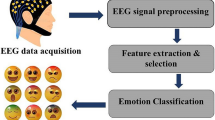Abstract
In affective computing, emotion classification has a significant role and renders many applications in the areas like neuroscience, entertainment, neuro-marketing, and education. These applications comprise classification of neurological disorder, false detection, recognition of stress and pain level, and finding level of attention. The traditional methods used for emotion recognition are facial expressions or voice tone. However, the outcomes of facial signs and verbal language can indicate the unfair and unclear results. Hence, investigators have started the usage of EEG (Encephalogram) method for analyzing the brain signals to recognize the various emotions. EEG-based emotion recognition has an ability to modify the way that we detect some health disorders. Brain signals reveal variations in electrical potential as a result of communication among thousands of neurons. This research article includes analysis of human affective state using DEAP- “Dataset for Emotion Analysis using Physiological Signals”. It is a multimodal dataset, where 40 channels are used, 32 subjects participated, and 40 one-minute video pieces of music was shown to them. The participants evaluated each music video with respect to Valence, Arousal, Dominance, and Likings.
Access this chapter
Tax calculation will be finalised at checkout
Purchases are for personal use only
Similar content being viewed by others
References
Koelstra S, Muhl C, Soleymani M, Lee J-S, Yazdani A, Ebrahimi T, Pun T, Nijholt A, Patras I (2012) Deap: a database for emotion analysis; using physiological signals. IEEE Trans Affect Comput 3(1):18–31
Ekman P (1989) The argument and evidence about universals in facial expressions. Hand-book of social psychophysiology, pp 143–164
Lindh V, Wiklund U, Hakansson S (1999) Heel lancing in term new-born infants: an evaluation of pain by frequency domain analysis of heart rate variability. Pain 80(1–2):143–148
Posner J, Russell JA, Peterson BS (2005) The circumplex model of affect: an integrative approach to affective neuroscience, cognitive development, and psychopathology. DevPsychopathol 17(3)
Klem GH, Lu¨ders HO, Jasper H, Elger C et al (1999) The ten-twenty electrode system of the international federation. Electroencephalogr Clin Neurophysiol 52(3): 3–6
Vanitha V, Krishnan P (2016) Real time stress detection system based on EEG signals
Liao C-Y, Chen R-C, Tai S-K (2018) Emotion stress detection using eeg signal and deep learning technologies. In: 2018 IEEE international conference on applied system invention (ICASI). IEEE, New York, pp 90–93
Koelstra S et al (2011) Deep: a database for emotion analysis; using physiological signals. IEEE Trans Affect Comput 3:18–31
Bazgir O, Mohammadi Z, Habib SAH, Emotion recognition with machine learning using eeg signals. IEEE
Jia W et al (2012) Electroencephalography (eeg)-based instinctive brain-control of a quadruped locomotion robot. In: 2012 annual international conference of the IEEE engineering in medicine and biology society. IEEE, New York, pp 1777–1781
Fakhruzzaman MN, Riksakomara E, Suryotrisongko H (2015) EEG wave identifcation in human brain with emotiv epoc for motor imagery. Proc Comput Sci 72:269–276
Shariat S, Pavlovic V, Papathomas T, Braun A, Sinha P (2010) Sparse dictionary methods for EEG signal classification in face perception. In: 2010 IEEE international workshop on machine learning for signal processing. IEEE, New York, pp 331–336
Tabar YR, Halici U (2016) A novel deep learning approach for classifcation of EEG motor imagery signals. J Neural Eng 14:016003
Chambon S, Thorey V, Arnal PJ, Mignot E, Gramfort A (2018) A deep learning architecture to detect events in EEG signals during sleep. In: 2018 IEEE 28th international workshop on machine learning for signal processing (MLSP). IEEE, New York, pp 1–6
Bashivan P, Rish I, Yeasin M, Codella N (2015) Learning representations from EEG with deep recurrent-convolutional neural networks. arXiv preprint arXiv:1511.06448
Pion- L, Kreutz K, Makeig S (2019) ICLABEL: an automated electroencephalographic independent component classifer, dataset, and website. NeuroImage 198:181–197
Struck AF et al (2019) Comparison of machine learning models for seizure prediction in hospitalized patients. Ann Clin Transl Neurol 67:1239–1247
Li S, Feng H (2019) EEG signal classification method based on feature priority analysis and CNN, pp 403–436
Sharma A, Emotion recognition using deep convolutional neural network with large scale physiological data
George FP,Shaikat IM, Ferdawoos PS, Parvez MZ, Uddin J (2019) Recognition of emotional states using EEG signals based on time-frequency analysis and SVM classifier. Int J Electr Comput Eng (IJECE) 9(2):1012–1020
Doma V, Pirouz M, A comparative analysis of machine learning methods for emotion recognition using EEG and peripheral physiological signals for emotion recognition using EEG and peripheral physiological signals
Asghar MA, Khan MJ, Amin FY, Rizwan M, Rahman M, Badnava S, Mirjavadi SS, EEG-based multi-modal emotion recognition using bag of deep features: an optimal feature selection approach. Sensors
Author information
Authors and Affiliations
Corresponding author
Editor information
Editors and Affiliations
Rights and permissions
Copyright information
© 2021 The Author(s), under exclusive license to Springer Nature Singapore Pte Ltd.
About this paper
Cite this paper
Kulkarni, S., Patil, P.R. (2021). Analysis of DEAP Dataset for Emotion Recognition. In: Bhattacharyya, S., Nayak, J., Prakash, K.B., Naik, B., Abraham, A. (eds) International Conference on Intelligent and Smart Computing in Data Analytics. Advances in Intelligent Systems and Computing, vol 1312. Springer, Singapore. https://doi.org/10.1007/978-981-33-6176-8_8
Download citation
DOI: https://doi.org/10.1007/978-981-33-6176-8_8
Published:
Publisher Name: Springer, Singapore
Print ISBN: 978-981-33-6175-1
Online ISBN: 978-981-33-6176-8
eBook Packages: Intelligent Technologies and RoboticsIntelligent Technologies and Robotics (R0)




